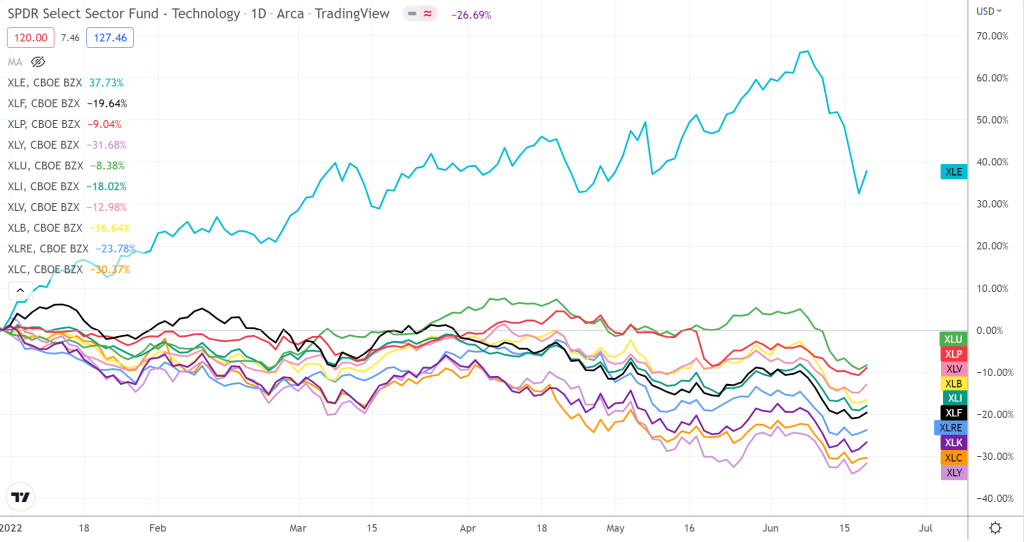
Hazelle
in Memos & Musings · 4 min read
The technology sector has been down by more than 30% from its highs as of early June 2022 and the bears have taken over the Nasdaq which is mainly concentrated in the IT sector. Things seem to be getting more discouraging with news of tech companies facing layoffs to cut costs and in anticipation of economic slowdown. Are tech stocks still investable? Should we take this opportunity to buy tech stocks at great prices?
Let’s first take a look at an overall picture of how the various sector ETFs have performed since the start of the year. Year to date, the XLK and XLC ETFs which have holdings in tech stocks such as Microsoft, Adobe, and Alphabet, have been among one of the worst performers in 2022.


Performance of Sector ETFs as at 21 June 2022
Why are tech stocks hit the hardest?
To understand this, we got to understand the concept of discounted cash flow. During times when we are in a very low interest rate environment, the future earnings of these growth stocks are discounted at a low interest rate which results in higher valuation. But when interest rates rise, the future earnings are discounted at a higher rate which causes the valuation of the tech stocks to fall. That’s the conceptual explanation based on discounted cash flow.
If that seems a little too technical, and you want to understand more on the logic, here it is! When money does not cost you that much, that means the cost to borrow is lower, it is alright for us to receive the profits that growth stocks generate 10 years or 15 years down the road. That is also why many unprofitable tech stocks which have high revenue growth rates had very high valuations previously. However, when the cost of money goes up higher, in other words, when interest rates increase, the value of these deferred cash flows will decline. Growth stocks such as tech stocks in particular, are hit harder than value stocks by the change in interest rates because the cash flows are further into the future.
With the negative sentiments that we are facing, do tech stocks still make a good investment? Here are some reasons why we think that tech stocks may still do well over the long term.
Growing demand for technology
The biggest question to ask ourselves is: would there be growing demand for technology services moving forward?
Just take a look at how the world has changed in recent years. In China, almost the entire population in the cities downloaded apps such as WeChat Pay and Alipay to integrate mobile payments into their daily lives. For retail investors looking to invest, various investment brokerage companies facilitate an easy and interactive investing experience where investors can invest from smartphone apps and consume content on that same app.
Closer to home, we also see that Fairprice embarked on its Scan & Go initiative where shoppers can scan the barcodes of their groceries on the go for a seamless shopping experience. Even museums these days incorporate technology to create more unique experiences for the visitors.
At the back end, businesses utilize technology solutions to improve their workflow and processes, incorporating automation and data analysis to increase productivity, efficiency and deliver higher quality services.
The pandemic has also accelerated the need for businesses to embark on digitisation. Technological innovation is no longer an option now, but an essential to survival for businesses.
To add on, the global labour shortage that the world is facing currently may also accelerate the use of automation to offset the impact of labour shortage by cutting down on the mundane, repetitive and time consuming tasks that the workforce handles.
The secular growth drivers in technology are here to stay and would be more deeply rooted in the markets going forward. While we are currently experiencing volatile periods, the sustainable growth offered by the tech companies will likely return to favour.
P/E of Nasdaq 100 is near its long term average
In terms of valuation, it seems that the current valuation of the Nasdaq is nearing its long term average after a big rally in the last 2 years. If investors were rushing to buy during the pandemic-era rally, why not buy now when prices are cheaper?


Tech layoffs, is it really all bad?
In fact, the recent news of tech companies freezing hiring or executing layoffs may not necessarily be entirely bad news. In some ways, this might help to loosen the tight labor market we are having right now. That may then bring down wages and bring about deflationary impact.
There are also some who think that the current tech layoff is an indication of an upcoming recession because during a recession, there are usually more layoffs and unemployment. On the bright side of things, many other industries are still lacking workers. So perhaps it is just not all doom and gloom.
Do not buy blindly - not all tech stocks are great stocks
But before you get overly excited and start your shopping spree in the stock markets, don’t forget about the fundamentals of the tech companies! Please do not get me wrong and start investing in any tech companies you know. It doesn’t mean that if a stock is a tech stock, it is a good stock.
We want to only invest in those businesses which have shown healthy financials and are still poised to grow. Especially during this interest rate hike period, where valuations of tech stocks are deflated due to the rising interest rates, we want to avoid flashy growth stocks which are still struggling to make profits and do not have wide moats. Instead, we want to hold businesses which have a track record of healthy financials, companies which are profitable and can continue to maintain their strong pricing power despite the inflationary period. Businesses which consumers are still willing to pay for their products and services even if they raise the pricing. Businesses which have sufficient cash flow to tide through the difficult times.
Let’s always remember that in investing, fundamentals are our last line of defence. Though the tech sector is being beaten down due to the current economic condition, strong fundamentals are what would bring up the prices of quality businesses at the end of every bear market.
Closing thoughts
Do note that this sharing does not mean that the tech stocks will rebound back immediately in the markets. But if you are an investor, then you should look at the bigger picture, set longer-term perspectives and consider the long term outperformance of your investments. In the short term, even the best company in the world or any Warren Buffett-endorsed stock can be beaten down temporarily.



About Hazelle
Chief trainer of The Moneyball Investors Playbook program and founder of The Joyful Investors, a financial education firm that seeks to help avid investors learn to invest better and make the journey a joyful one. I graduated with a first class honors in Bachelor of Accountancy from Nanyang Technological University (NTU) and started my auditing career in one of the Big Four. I believe that once we know how to build our wealth sustainably, we can then live our best lives ever.
Important Information
This document is for information only and does not constitute an offer or solicitation nor be construed as a recommendation to buy or sell any of the investments mentioned. Neither The Joyful Investors Pte. Ltd. (“The Joyful Investors”) nor any of its officers or employees accepts any liability whatsoever for any loss arising from any use of this publication or its contents. The views expressed are solely the opinions of the author as of the date of this document and are subject to change based on market and other conditions.
The information provided regarding any individual securities is not intended to be used to form any basis upon which an investment decision is to be made. The information contained in this document, including any data, projections and underlying assumptions are based upon certain assumptions and analysis of information available as at the date of this document and reflects prevailing conditions, all of which are accordingly subject to change at any time without notice and The Joyful Investors is under no obligation to notify you of any of these changes.
· · ·
Have you enjoyed this article? We’d be grateful if you would share this useful content to your friends who may benefit from it as well.



